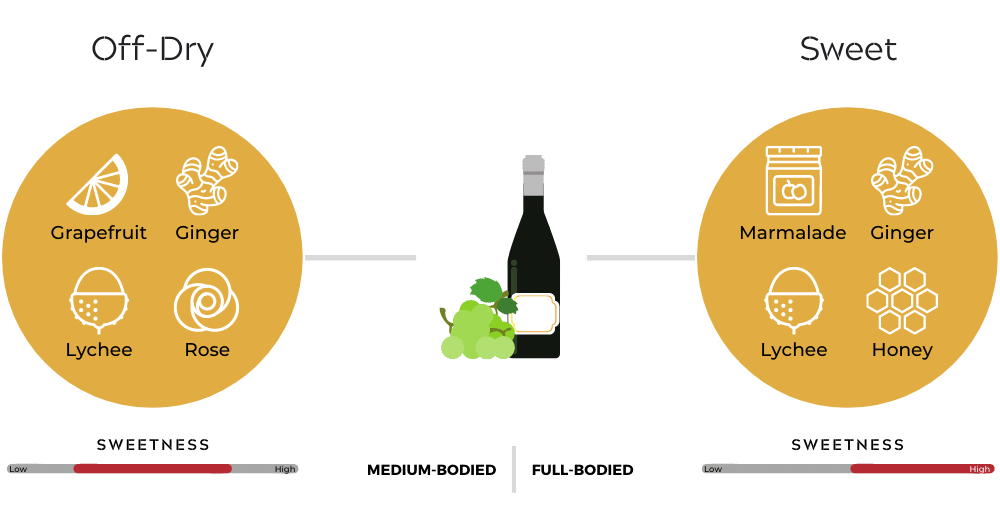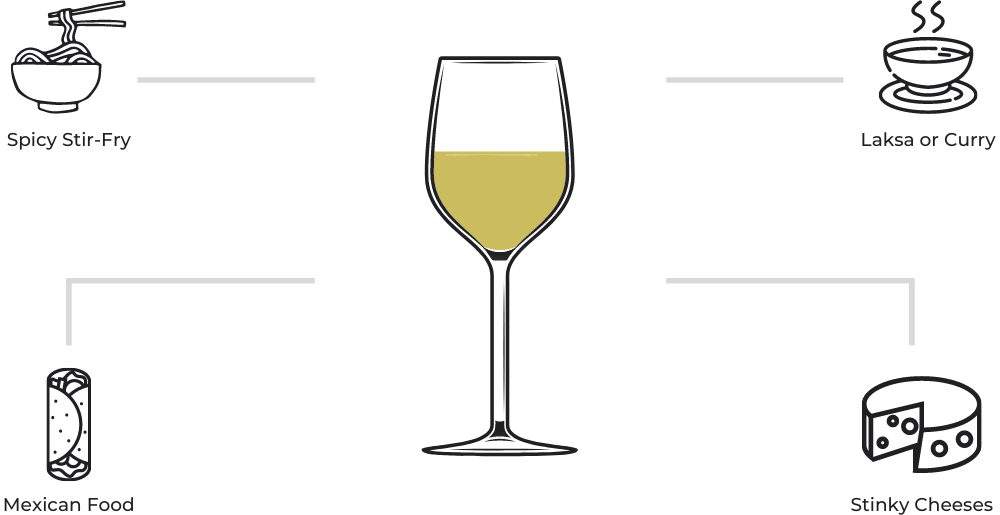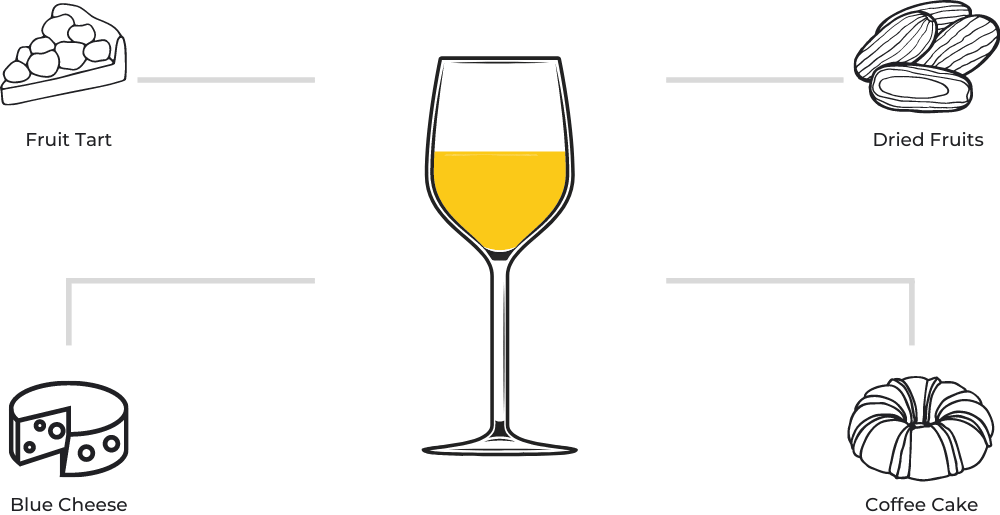Instantly recognisable because of their incredibly unique name, bottles of Gewurztraminer are unfortunately often relegated to very small sections of a bottle shop's fridge or shelf space, assuming they’re even given any space at all.
Whilst their name might be anything but approachable, these wines are actually rather sweet and easy-drinking in their style, making it common for them to be compared to or against the more well-known bottles of Moscato.
When looking to begin your journey into tasting them, it can seem pretty daunting, especially considering that most casual or part-time bottle shop sales assistants or restaurant waiters will know about as much as you do about them, which is to say, absolutely nothing.
To help with this, we’ve provided you, with the aid of graphics, with all that you need to know in order to comfortably pick the right bottle of Gewurztraminer wine for you and your tastes when browsing online or in-store.
By the end of this you will have a stronger idea of the typical flavour profile of these wines, including their average levels of sweetness and acidity, what many of the prominent flavours and characteristics commonly associated with these wines are, as well as the types of food that they typically match best with.
For those in a rush or looking to first get a very quick overview before jumping in, we recommend that you check out our quick guide to the style on our Other White Wine Varietals page, where a simple and easy-to-understand graphical summary is provided.
Why is it Called Gewurztraminer?

Before we get into how this wine tastes, let’s first clear up exactly how it should be spelt.
Depending upon where the bottle of wine you’re holding is from, you might find it labelled Gewurztraminer or Gewürztraminer.
Whilst you might think that this is a printing mistake, it is actually the case that the spelling that doesn’t include the two dots above the u is the non-German way of spelling it, making it commonly found on bottles of this style originating outside of Germany, even though both ways of spelling are referring to exactly the same grape.
Looking beyond the exact spelling, the varietal itself is thought to be a direct descendant or at least very close relative of two other very rare species of grapes, being Traminer and Savagnin, leading many to believe that this is where the name of the wine comes from.
Whilst the verdict is still out on how this grape varietal actually came into existence and got its name, we do know that it was historically and continues to remain today incredibly popular amongst winemakers in the German and Alsatian wine regions, making these parts of Central and Western Europe the historical home of this ancient and noble grape varietal.
How Do Gewurztraminer Wines Taste?

Putting the history and spelling of the grape varietal aside, Gewurztraminer wines are known for their characteristically bold colouring and incredibly strong and intense smell and taste.
Some of the more common aromas and flavours mentioned often include lychee, rose petal, pepper, ginger, cinnamon, pineapple, mango, peach, and grapefruit, with exact variations in flavour, sweetness, acidity, and smell occurring depending upon the conditions in which the grapes used to produce the wine were grown and the winemakers preference.
In any region it comes from, however, the wine can appear as either slightly off-dry and somewhat minerally and bitter in its style or full-bodied and super sweet.
The trick in trying to figure out how the bottle you’re considering to purchase will likely taste is to look at two of its most obvious attributes, which are its level of alcohol and its colour.
Generally speaking, those examples that are lower than around 10% ABV in their levels of alcohol and intensely golden or deep in their colouring will tend to be sweeter in their flavour profile, whilst those that are above 10% ABV and slightly less golden and decidedly more pale in their colouring will tend to be somewhat drier and often more bitter in their finish.
This definitely isn’t a foolproof way of choosing the right bottle for you, however, so it is always recommended that you try and seek out tasting notes on a specific bottle when you’re trying to get the perfect match for you and your tastes.
It is also important to remember that no matter where or in what style it’s produced, Gewurztraminer wines are characterised by their medium to low levels of natural acidity, which can make it very difficult for winemakers who choose to produce them being able to achieve an optimal balance of refreshing acidity and appropriate sweetness.
It is partly because of this reason that only around 20,000 acres of vineyard space worldwide is dedicated to the production of Gewurztraminer wines, making them a rare but incredibly rewarding style of white wine for those that know how to pick the right one.
How to Pair Food with Gewurztraminer Wines

Now that we know that bottles of Gewurztraminer can taste variably off-dry to very sweet, let’s move on to how to match both examples with food.
Most experts would agree that it’s best to separate the perfect food pairing option based on whether the bottle being considered is made to a drier or sweeter style as each one has its own optimal pairing recommendation.
Off-Dry Styles

Those that are made to distinctly more off-dry fashion, which describes most of the bottles that you’ll find at major liquor retail outlets, these can be paired best with almost any kind of dish that includes moderate amounts of hot spice, including Asian stir-frys or Mexican food, a light seafood curry or laksa, or most kinds of moderately stinky or flavoured cheeses, such as Alsatian Munster, Roquefort, Stilton, or Gouda.
Our recommended bottle of choice for an off-dry Gewurztraminer wine that is often fairly easy to get your hands on is the Dopff-Au-Moulin Gewurztraminer, which is available at most BWS or Dan Murphy’s stores.
Sweet Styles

When you’re looking to pair a rich, bold, heavy, and sweeter style of Gewurztraminer wine, however, make sure to match these with almost any kind of fruit tart, in particular those made with apples, a dried fruit platter or dessert, especially dried mango, or basically any kind of dessert that includes noticeable amounts of cinnamon or ginger spice.
For those who wish to begin their journey on the sweeter end of the spectrum, we recommend that you look out for the Rymill June Traminer Botrytis Gewürztraminer, which can be found on the popular wine and spirits delivery website Nick’s.